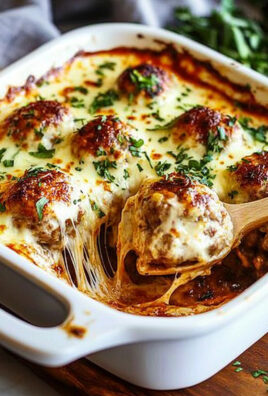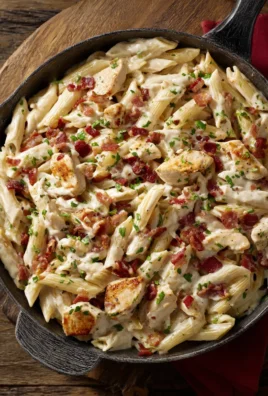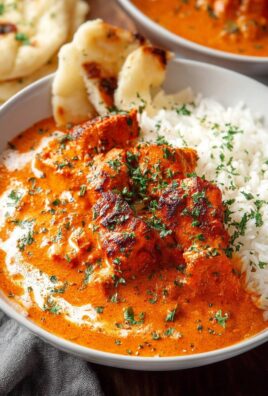Fettuccine Alfredo is more than just a pasta dish; it’s a culinary hug, a creamy, dreamy experience that has captured hearts around the globe. Have you ever wondered about the simple elegance of perfectly cooked fettuccine coated in a velvety, rich sauce, so seemingly complex yet born from humble beginnings? I certainly have, and the story behind this iconic meal is as delightful as the dish itself. Its universal appeal lies in its comforting simplicity and profound flavor, making it a go-to for countless special occasions and weeknight indulgences alike.
The Enduring Legacy of True Fettuccine Alfredo
I find it fascinating that the original Fettuccine Alfredo, created by Alfredo di Lelio in Rome over a century ago, was conceived as a comforting meal for his wife. It famously contains just three core ingredients: fresh fettuccine, high-quality butter, and finely grated Parmigiano-Reggiano cheese. This classic Roman preparation, often called “bianco e burro” (butter and cheese), showcases the incredible alchemy that occurs when these simple components emulsify into a luxurious, clingy sauce without a drop of cream. People adore this dish for its profound depth of flavor, its incredible mouthfeel, and the sheer comfort it provides. It’s a testament to how extraordinary food can be when made with passion and quality ingredients, proving that sometimes, less truly is more. The simplicity yet profound satisfaction derived from each twirl of pasta makes it an enduring favorite on dinner tables everywhere, solidifying its place as a timeless comfort food.
Ingredients:
- 1 pound (450g) fresh fettuccine pasta: While dried fettuccine will certainly work, I find that fresh pasta truly elevates this dish, providing a superior texture that perfectly clings to the luxurious sauce. If using dried, aim for a high-quality brand.
- 1 cup (225g) unsalted butter: This is the foundation of our magnificent sauce, so choose a good quality butter. I always prefer unsalted so I can control the seasoning myself.
- 2 cups (480ml) heavy cream: Opt for full-fat heavy cream (at least 36% milk fat) for the richest, most decadent sauce. This isn’t the place to cut corners with lighter creams if you want that authentic Alfredo experience.
- 2 cups (about 8 ounces or 225g) freshly grated Parmigiano-Reggiano cheese: And I mean freshly grated! Please, resist the urge to use pre-grated cheese from a bag. Those often contain anti-caking agents that prevent them from melting smoothly into a sauce. Parmigiano-Reggiano, with its nutty, salty, and slightly pungent flavor, is non-negotiable for true Fettuccine Alfredo. Reserve a little extra for garnishing.
- 2 cloves garlic (optional, but highly recommended): Finely minced. While traditional Alfredo is pure butter, cream, and cheese, a touch of garlic adds a wonderful aromatic depth that I personally adore.
- 1 teaspoon sea salt, plus more for pasta water: We’ll season the sauce to taste, but a generous amount of salt in the pasta water is essential for flavorful pasta.
- ½ teaspoon freshly ground black pepper: Freshly ground makes a big difference in flavor compared to pre-ground.
- ¼ teaspoon freshly grated nutmeg (optional, but a secret weapon): Just a pinch of nutmeg, freshly grated, can add a subtle warmth and complexity that rounds out the flavors beautifully without making the dish taste “nutmeg-y.” Trust me on this one.
- ½ cup (120ml) reserved pasta water: This starchy, salty liquid is your best friend when emulsifying the sauce and achieving that perfect, glossy consistency. Don’t forget it!
- Fresh parsley or chives (optional, for garnish): Finely chopped, for a pop of color and freshness.
Gathering and Prepping Your Ingredients
- Set Up Your Station: Before you even think about turning on the stove, gather all your ingredients. This is a dish that comes together quite quickly once you start, and you don’t want to be scrambling for something mid-process. I always find a well-organized workspace makes the cooking experience so much more enjoyable.
- Grate Your Cheese: If you haven’t already, take out your block of Parmigiano-Reggiano and grate it finely. I prefer using a microplane or the fine side of a box grater for this. This ensures the cheese melts quickly and smoothly into the sauce without clumping. Remember my earlier note: freshly grated is paramount for the best results!
- Measure Everything Else: Measure out your butter, heavy cream, salt, pepper, and nutmeg. If you’re using garlic, go ahead and mince your two cloves now. Having everything portioned and ready to go in small bowls (this is often called “mise en place”) will make the cooking process seamless and stress-free. Trust me, you’ll thank yourself later when you’re whisking away and don’t have to pause to measure.
Cooking the Fettuccine to Perfection
The pasta is just as important as the sauce in Fettuccine Alfredo. We want it perfectly cooked, al dente, and ready to embrace that rich, creamy goodness.
- Boil Water for Pasta: Grab a large pot, the biggest one you have available. You want plenty of room for the fettuccine to swim freely, which prevents it from sticking together. Fill it about two-thirds full with water.
- Salt the Water Generously: This is a crucial step that many overlook, but it’s essential for flavoring the pasta itself. Think of it like seasoning the pasta from the inside out. I usually add a generous handful of salt – it should taste like the sea. For 4-6 quarts of water, I’d typically use 1 to 2 tablespoons of salt. Don’t be shy here; most of this salt will go down the drain, but enough will infuse your pasta with flavor.
- Bring to a Rolling Boil: Place the pot on high heat and bring the water to a vigorous, rolling boil. You want lots of bubbles, indicating enough energy to cook the pasta efficiently.
- Add the Fettuccine: Carefully add your fresh fettuccine to the boiling water. If you’re using dried fettuccine, add it slowly and gently push it down as it softens. Immediately stir the pasta with tongs or a long spoon to prevent it from sticking to itself or the bottom of the pot. Continue to stir occasionally during cooking.
- Cook to Al Dente: Fresh fettuccine cooks very quickly, often in just 2-4 minutes. Dried pasta will take longer, usually 8-12 minutes, depending on the brand and thickness. You want to cook the pasta until it’s “al dente,” which means “to the tooth.” It should be tender but still have a slight bite or firmness in the center, not mushy. I always recommend tasting a strand about a minute before the package directions suggest.
- Reserve Pasta Water: This step is absolutely critical! Just before you drain the pasta, carefully scoop out about ½ to 1 cup of the starchy, salty pasta water using a heatproof measuring cup or ladle. This cloudy, flavorful liquid is a magical emulsifier and thinner for our Alfredo sauce. It will help bind the sauce to the pasta and achieve that perfect, glossy consistency. Do not skip this!
- Drain the Pasta: Once the pasta is perfectly al dente, immediately drain it using a colander. Do not rinse the pasta! Rinsing removes the beneficial starch clinging to the pasta, which is vital for the sauce to adhere properly. Let it sit in the colander for just a moment to shed excess water, but don’t let it get cold. We want to add it to the sauce while it’s still warm and steamy.
Crafting the Velvety Alfredo Sauce
Now for the star of the show: the rich, creamy, and utterly irresistible Alfredo sauce. Patience and gentle heat are your best friends here.
- Melt the Butter: While your pasta is draining (or even while it’s cooking, if you’re a multi-tasker), grab a large, wide, heavy-bottomed skillet or sauté pan. A wider pan is better as it gives you more surface area to work with the sauce and eventually toss the pasta. Place the pan over medium-low heat. Add the entire cup of unsalted butter and let it melt slowly and gently. We are looking for melted butter, not browned butter, so keep the heat low to prevent it from scorching or separating.
- Sauté the Garlic (if using): Once the butter is fully melted and shimmering, add your finely minced garlic (if you’re including it). Sauté it for just about 30 seconds to 1 minute, or until fragrant. Be careful not to let it brown, as burnt garlic can taste bitter. We just want to infuse the butter with its lovely aroma.
- Add the Heavy Cream: Pour in the 2 cups of heavy cream. Stir gently to combine it with the melted butter and garlic. Increase the heat slightly to medium-low or medium, and bring the cream mixture to a gentle simmer. You’ll see small bubbles forming around the edges of the pan, and the cream will begin to thicken ever so slightly. Do not let it come to a rolling boil, as this can cause the cream to separate or become grainy. We want a serene, gentle simmer.
- Season the Cream: Stir in the 1 teaspoon of sea salt, ½ teaspoon of freshly ground black pepper, and the ¼ teaspoon of freshly grated nutmeg (if using). Taste the cream mixture and adjust the salt if needed. Remember, the cheese we’ll add is also salty, so don’t over-salt at this stage.
-
The Crucial Cheese Integration (Off Heat!): This is perhaps the most important step for a smooth, velvety sauce. Once the cream is gently simmering and slightly thickened, remove the pan from the heat entirely. Seriously, take it off the burner. Now, gradually add your freshly grated Parmigiano-Reggiano cheese to the cream mixture, a handful at a time, whisking continuously.
Why Remove From Heat?
Adding cheese directly to a very hot liquid can cause the proteins in the cheese to seize up, resulting in a stringy, clumpy, or oily sauce rather than a smooth, emulsified one. By removing the pan from the direct heat, you allow the residual warmth of the cream to melt the cheese slowly and evenly, creating a beautiful emulsion.
Keep whisking until each addition of cheese has fully melted and integrated into the sauce before adding the next. The sauce will thicken considerably and become wonderfully glossy and luxurious. If it seems too thick, you can add a tablespoon or two of your reserved pasta water here to reach your desired consistency.
Bringing It All Together: The Grand Finale
The moment of truth! Combining the perfectly cooked pasta with our magnificent sauce to create the ultimate Fettuccine Alfredo.
- Add Pasta to Sauce: Immediately transfer your hot, drained fettuccine directly into the pan with the Alfredo sauce. The warmth of the pasta will help keep the sauce at the perfect temperature for tossing.
- Toss and Emulsify: Using tongs, gently but vigorously toss the pasta with the sauce. You want to coat every single strand evenly. The residual starch on the pasta, combined with the heat and the motion, will help the sauce emulsify even further, becoming incredibly creamy and clingy.
- Adjust Consistency with Pasta Water: As you toss, observe the consistency of the sauce. If it seems too thick, or if it’s not coating the pasta as luxuriantly as you’d like, add your reserved pasta water, one tablespoon at a time, continuing to toss. The starch in the pasta water helps to create a perfect, glossy, and cohesive sauce that lovingly clings to each strand of fettuccine. You might use anywhere from a few tablespoons up to the full ½ cup, depending on how thick your sauce started and your personal preference.
- Final Taste and Seasoning: Give the dish a final taste. Does it need a tiny pinch more salt? A twist of black pepper? Maybe another whisper of nutmeg? Adjust as needed. Remember, the sauce should be rich, savory, and perfectly balanced.
Serving Suggestions and Pro Tips
Fettuccine Alfredo is a dish best enjoyed fresh and immediately. Here are a few tips to make the most of your culinary masterpiece.
- Serve Immediately: This is perhaps the most important rule of Fettuccine Alfredo: serve it as soon as it’s made. This dish does not wait well. The sauce will begin to seize up and thicken as it cools, and it will lose its luxurious texture. Have plates ready, forks waiting, and gather your hungry diners around the table the moment it’s finished.
- Garnish: As you plate the fettuccine, sprinkle each serving with a little extra freshly grated Parmigiano-Reggiano cheese. A light scattering of finely chopped fresh parsley or chives adds a lovely touch of color and a hint of freshness that cuts through the richness beautifully.
- Pairing Perfection: This is a rich dish, so I like to balance it with something fresh. A simple side salad with a light vinaigrette is always a good choice. Crusty garlic bread or a warm baguette is also fantastic for soaking up any extra sauce. For drinks, a crisp white wine like a Pinot Grigio or Chardonnay, or even a light-bodied red like a Chianti, can complement the flavors without overwhelming them.
- Don’t Reheat (Seriously!): I cannot emphasize this enough. Fettuccine Alfredo is one of those dishes that truly suffers in the reheating process. The butter and cheese in the sauce tend to separate and become oily, and the pasta gets mushy. If you absolutely must reheat, do it very gently on the stovetop with a splash of milk or cream, stirring constantly, but be warned, it will never be as good as the first time around. My advice? Make only as much as you plan to eat in one sitting.
- Quality Over Quantity: As I mentioned throughout the recipe, the quality of your ingredients truly shines in a simple dish like Fettuccine Alfredo. High-quality butter, fresh heavy cream, and authentic Parmigiano-Reggiano are not just suggestions; they are key to achieving that restaurant-quality taste and texture. Don’t compromise on these core components.
- Experiment (Carefully): While I advocate for the classic version, once you’ve mastered it, you can certainly experiment. Some people love adding pan-seared chicken breast, sautéed shrimp, or even sliced mushrooms to their Alfredo. If you do this, prepare your additions separately and fold them into the finished pasta and sauce just before serving. This ensures they don’t impact the sauce’s delicate balance while it’s being made. Just remember that the simplicity of the original is often its greatest strength.
- Embrace the Process: Cooking, especially something as comforting as Fettuccine Alfredo, should be an enjoyable experience. Take your time, pay attention to the details, and trust your instincts. The result will be a dish that brings warmth and satisfaction to everyone at your table, especially yourself! Enjoy creating this timeless classic.

Conclusion:
Okay, my friends, we’ve reached the grand finale of our culinary adventure, and I truly hope you’ve enjoyed the journey as much as I have guiding you through this exquisite dish. What we’ve crafted together isn’t just another meal; it’s a testament to the power of simple, high-quality ingredients transforming into something truly extraordinary. This isn’t just any pasta dish; it’s a symphony of flavors, a creamy, dreamy masterpiece that consistently delivers pure comfort and unparalleled satisfaction. I’m talking about a richness that coats your palate perfectly, a subtle garlic hum, and the luxurious texture of perfectly cooked pasta enrobed in a velvety sauce. It’s the kind of meal that makes you close your eyes and savor every single bite, a dish that feels indulgent yet surprisingly approachable to create in your own kitchen. This particular recipe, with its careful balance and easy-to-follow steps, guarantees a restaurant-quality experience right at your dining table, without any of the fuss or exorbitant prices. Believe me, once you master this, it’s going to become a staple in your rotation, a go-to for special occasions, cozy nights in, or simply when you crave something utterly delicious and comforting.
But the magic doesn’t stop once the pasta hits the plate. Oh no, that’s just the beginning of the possibilities! While a classic bowl of this incredible pasta is a showstopper on its own, it’s also remarkably versatile, ready to adapt to your cravings and whatever you have on hand. For a traditional Italian-American feast, I highly recommend pairing it with some warm, crusty garlic bread to sop up every last drop of that magnificent sauce, and a fresh, crisp green salad with a light vinaigrette to cut through the richness.
Elevate Your Meal with These Delicious Additions:
- Protein Power-Ups: Want to make it a more substantial meal? Grilled chicken breast, sautéed shrimp, or even some crispy pancetta or bacon bits sprinkled on top are absolutely divine additions. For something a bit more gourmet, thin slices of pan-seared steak can turn this into an elegant dinner party main course.
- Veggie Boost: Don’t shy away from adding some vibrant vegetables! Steamed broccoli florets, sautéed mushrooms, wilted spinach, or even a handful of sweet peas can not only add color and nutrients but also wonderful texture and flavor contrasts. I particularly love the earthiness that mushrooms bring to the creamy sauce.
- Herbaceous Touches: A sprinkle of fresh parsley or chives at the end can brighten the entire dish with its fresh aroma and visual appeal. You could even experiment with a touch of fresh thyme if you’re feeling adventurous.
- Cheese Exploration: While Parmigiano-Reggiano is king here, a tiny grating of fresh nutmeg can add an unexpected warmth and depth that really makes the flavors sing. You could also experiment with a blend of cheeses, perhaps adding a small amount of Pecorino Romano for a sharper, saltier kick, though I advise caution to maintain the classic creaminess.
- Make it Your Own: If you’re looking to lighten it up slightly, you could experiment with using a combination of heavy cream and milk, though I personally vouch for the full-fat glory of cream in this particular recipe for that authentic richness. Conversely, for an even more intense cheese flavor, consider stirring in a bit of cream cheese or mascarpone at the very end for an extra luscious texture.
This adaptability means that while the core recipe for our Fettuccine Alfredo remains perfect, you have endless opportunities to personalize it, making it uniquely yours every time.
So, my dear fellow food enthusiasts, I implore you: don’t just read about this incredible pasta; make it! Set aside an evening, gather your ingredients, put on some good music, and immerse yourself in the joy of creating something truly spectacular from scratch. You’ll be amazed at how quickly it comes together and how immensely satisfying the process is. The aroma alone as the sauce simmers will fill your kitchen with a promise of deliciousness that few other dishes can rival.
I am genuinely excited for you to experience the sheer delight of twirling those silken strands of pasta around your fork, savoring the rich, comforting taste that only a perfectly executed Alfredo can provide. This isn’t just about feeding yourself; it’s about nourishing your soul, sharing good food with loved ones, and celebrating the simple pleasures of life.
And when you do, please, please, please come back and tell me all about it! I absolutely adore hearing about your culinary adventures. Did you add shrimp? Did you pair it with a specific wine? What was your family’s reaction? Share your photos, your triumphs, and any clever twists you came up with in the comments section below. Your feedback and experiences are incredibly valuable, not just to me, but to the entire community of home cooks who are looking for inspiration and confirmation that a recipe is worth trying. Let’s build a beautiful collection of delicious experiences together. I can’t wait to see your creations! Happy cooking, and bon appétit!

Best Homemade Fettuccine Alfredo – Quick & Cheesy Meal!
A creamy, dreamy experience of perfectly cooked fettuccine coated in a velvety, rich sauce. This iconic dish, originally from Rome, features fresh fettuccine, high-quality butter, and finely grated Parmigiano-Reggiano cheese, with heavy cream for extra decadence. Quick to prepare and profoundly satisfying, it’s a timeless comfort food.
Ingredients
-
1 lb (450g) fresh fettuccine pasta
-
1 cup (225g) unsalted butter
-
2 cups (480ml) heavy cream (full-fat)
-
2 cups (8 oz / 225g) freshly grated Parmigiano-Reggiano cheese
-
2 cloves garlic, minced (optional)
-
1 tsp sea salt, plus more for pasta water
-
½ tsp freshly ground black pepper
-
¼ tsp freshly grated nutmeg (optional)
-
½ cup (120ml) reserved pasta water
-
Fresh parsley or chives, chopped (optional, for garnish)
Instructions
-
Step 1
Grate Parmigiano-Reggiano, mince garlic (if using), and measure all other ingredients to have them ready. -
Step 2
Bring a large pot of generously salted water to a rolling boil. Add fettuccine and cook until al dente (2-4 minutes for fresh, 8-12 minutes for dried), stirring occasionally to prevent sticking. -
Step 3
Just before draining, scoop out ½ cup (120ml) of starchy pasta water. Drain pasta immediately; do not rinse. -
Step 4
In a large, wide skillet over medium-low heat, melt 1 cup of unsalted butter. If using, add minced garlic and sauté for 30-60 seconds until fragrant, being careful not to brown it. -
Step 5
Pour in 2 cups heavy cream. Stir gently and bring to a gentle simmer (small bubbles around the edges). Do not boil vigorously. Stir in 1 tsp sea salt, ½ tsp black pepper, and ¼ tsp nutmeg (if using). Taste and adjust salt. -
Step 6
Remove the skillet from heat. Gradually add freshly grated Parmigiano-Reggiano cheese, a handful at a time, whisking continuously until each addition is fully melted and integrated into the sauce. The sauce will thicken and become glossy. If too thick, add 1-2 tbsp of reserved pasta water. -
Step 7
Immediately add the hot, drained fettuccine directly into the skillet with the Alfredo sauce. Toss gently but vigorously with tongs to coat every strand evenly. -
Step 8
As you toss, add reserved pasta water, 1 tbsp at a time, if the sauce seems too thick or isn’t coating the pasta luxuriantly enough. Continue tossing until the sauce is perfectly glossy and clings to the pasta. -
Step 9
Taste the dish and adjust seasoning with a pinch more salt, pepper, or nutmeg if desired, ensuring a rich, savory, and balanced flavor. -
Step 10
Plate and garnish each serving with extra freshly grated Parmigiano-Reggiano and chopped fresh parsley or chives. Serve immediately, as this dish is best enjoyed fresh and does not reheat well.
Important Information
Nutrition Facts (Per Serving)
It is important to consider this information as approximate and not to use it as definitive health advice.
Allergy Information
Please check ingredients for potential allergens and consult a health professional if in doubt.




Leave a Comment